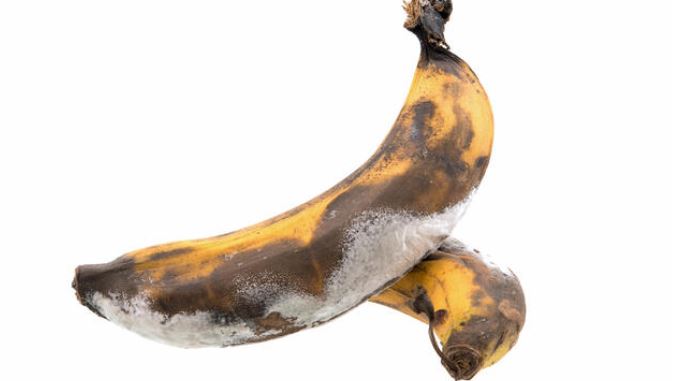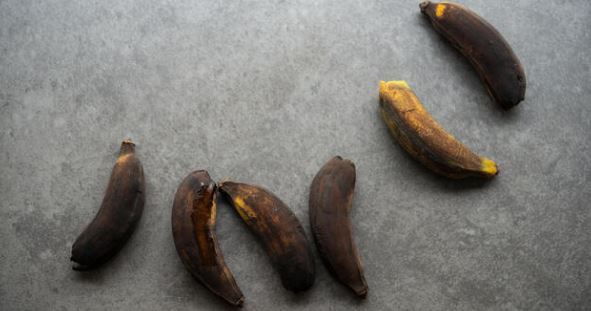Notice that beyond every single thing, your lovely banana has to decay at one point in life. Although plants and their fruits decompose, there may be some unusual accelerated rot that might cause a feeling of surprise to you. If your bananas get spoilt too quickly, these might be the reasons
Why Do Bananas Rot So Fast?
Bananas produce a colorless hydrocarbon gas known as ethylene before the onset of ripening. Unlike in many other fruits, bananas produce a slightly high amount of ethylene compare to other fruits.
The gas can be harmful and beneficial at the same time. Ethylene is an important plant hormone that induces and hastens ripening. It works by softening the fruit, dissolving pectin, converting starch and acids to sugar, and changing the color of the fruit. Once the fruit is fully developed, it triggers a steady release of the gas that speeds up aging and eventually rotting.

A rotting banana due to an uncontrolled amount of ethylene is characterized by rapid browning of the fruit and softening. Ethylene being a gas can spoil an enormous number of bananas within a short time if it is unchecked.
Banana Rotting is Caused by Post-Harvest Disease
- Another reason that may cause your banana to rot too quickly is because of a disease known as crown rot postharvest disease. The microorganism that causes the disease is the Fusarium species.
- Crown rot disease causes a biological disorder that causes black color spots and decay at the base of banana fingers.
The occurrence of crown rot disorder is during the ripening of the fruit due to increased respiration and transpiration.
Too low temperatures break down the cell wall of your banana and mix the contents of the cell. The result is that the fruit will soften abnormally, oxidize, and become brown. High temperature also increases the rate of respiration which may cause deterioration of the quality of the fruit.
Microorganisms such as fungi, yeast, and bacteria feed on the fruit and break it down, the presence of these microorganisms causes rapid rots on your banana.
Exposing your bananas to direct sunlight leads to the rapid escape of moisture, softening, and fast ripening. The rate at which ethylene is produced increases. Your banana fruit will not only have a bland flavor but also rot too quickly.
How To Prevent Bananas from Rotting?
Here is how you can keep your bananas fresh for a long time.
1. Hang your bananas on a banana holder
There is a scientific reason why your bananas will not rot too quickly if you hang them on a hook. When your banana is on a holder, the rate at which ethylene gas works is slowed. Hanged bananas are not likely to get brown bruises which usually attract microorganisms that speed up rotting.
2. Wrap the stems of your banana in a plastic bag.
Take your banana and wrap the stem with plastic wrap or aluminum foil. It will slow the rate at which ethylene gas is released from the stem. Be cautious not to cover the entire banana as it will rot quickly in a moist and warm environment. The ideal temperature to store a banana is 12 degrees Celsius protected from direct sunlight.
3. Put your banana in the fridge
The temperature in a fridge is too low to favor ripening. Too low temperatures inactivate the enzymes and stop the ripening process. Note that it is only advisable to keep fully ripe bananas in a refrigerator. Unripe bananas may stop the ripening process and cause them to taste bitter. Sometimes the peels of your banana may turn brown but it will stay fresh as long as it is in the fridge.
3. Treat your banana with citric acid
If you sprinkle your banana with lemon juice, the PH of the banana will be lowered due to the presence of citric acid in the lemon juice. Citric acid also prevents oxidation which would otherwise cause browning and rotting.
4. Keep your bananas away from direct sunlight
The heat from the sun raises the temperature of the fruit. When the fruit is warmed up, it ripens faster and may get softened too fast resulting in a bland-flavored fruit. There may also be the blackening of the banana peel due to the presence of an enzyme called polyphenol oxidase. This enzyme is naturally occurring in the banana peel and it is active when the temperature is high.
5. Store your banana separately from other fruits
Fruits like pineapple release produce a lot of ethylene during ripening. The most appropriate way to prevent ethylene from traveling to your banana is by storing it separately
What Do I Do with Rotten Bananas?
Do not eat rotten bananas, especially if it contains visible mold on the skin or microbes on the flesh.
A banana is okay if the peel is black or dark brown, but provided that the inside changes to brown too, then the banana is past ripe and it can no longer be safe for consumption. An additional indication that your banana has gone bad is if they begin to leak any fluid and give an unpleasant scent. For such conditions when you doubt your banana, discard it.
Rotting bananas are halfway through the decomposition process. Once they are broken down under a managed environment, you can include them in your compost. There, they will fully decompose and release nutrients that increase the quality of your compost manure and provide more benefits.
On condition that your banana has not gone extremely bad, you can decide to give them to your birds and pigs. But remember to remove the peels before giving your pigs and birds the banana because they can easily get choked.
References

